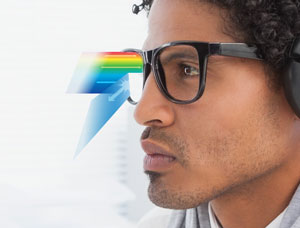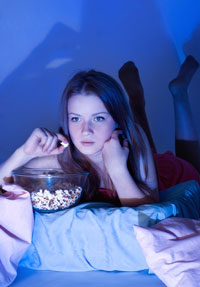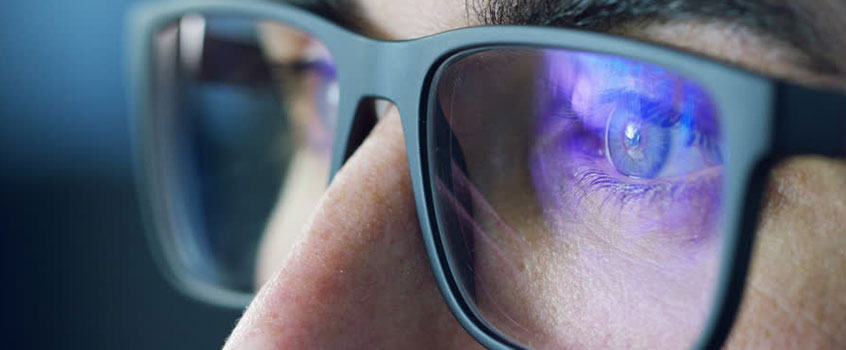Smartphones, tablets, computers and televisions have become a vital part of our everyday lives. We work, study and relax with them. Computer displays, television screens, smartphones, tablets and GPS devices all emit blue light. However, there is a downside to being constantly connected.
Research has shown that 83% of spectacle wearers experience some form of visual stress during or after using digital devices. Although blue light, more commonly known as high-energy visible light (HEV light) in itself is a natural phenomenon - it is present in daylight and helps us to stay awake - over exposure causes eye strain, eye fatigue and sleeplessness. Blue light protection is vital to deal with these harmful effects whilst ensuring visual comfort in the digital world.
Overview
Like ultraviolet radiation, visible blue light — the portion of the visible light spectrum with the shortest wavelengths and highest energy — has both benefits and dangers. Here are important things you should know about blue light.
Blue light is everywhere. Sunlight is the main source of blue light and being outdoors during daylight is where most of us get most of our exposure to it. But there are also many man-made, indoor sources of blue light, including fluorescent and LED lighting, flat-screen TV's and handheld digital devices.

Most notably, the display screens of computers, electronic notebooks, smartphones and other digital devices emit significant amounts of blue light. The amount of HEV light these devices emit is only a fraction of that emitted by the sun. But the amount of time most people spend using these devices and the proximity of these screens to the user's face have many eye doctors and other health care professionals concerned about the long-term effects of blue light on eye health.
Research has shown that more than 34% of people spend 4 to 6 hours a day with digital devices, while 14% even spends between 10 and 12 hours a day. In actual fact, as of 2016, people in the United Kingdom spend more time per day looking at a digital device, than sleeping.
It is therefore not surprising that more and more people complain about the following;
- Red and irritated eyes.
- Dry eyes.
- Blurred vision.
- Fatigue.
- Back, neck and shoulder pain.
- Headaches.
- Neutralises blue light, preventing from eye strain and fatigue.
- Reduces glare for more comfortable and relaxed vision.
- Better contrast perception, offering a more natural colour experience.
Features
- Protect against disruption to the natural circadian rhythm which regulates internal sleep-wake cycles.
- Neutralize blue light to prevent the associated eye strain and visual fatigue.
- Reduce the dry, gritty, sandy feeling most commonly associated with digital eyestrain.
- Enhance contrast perception offering a more natural colour experience.
- Reduce glare for more comfortable and relaxed vision.
- Protect your lenses against water, dirt, grease and dust - Keeping them cleaner for longer.
Technology
It makes sense that clear spectacle lenses do not require UV protection if only worn indoors, however it is advised that clear lenses include blue light protection. But why?
No matter your age, limiting your exposure to blue light and protecting your eyesight will ensure that you enjoy many more years of healthy vision.

Blue light radiation from light sources or screens has significant adverse health affects for the body and the eye, aside from the visual discomfort. A blue light filter provides sharper vision: the different wavelengths of visible light are refracted in slightly different ways by the cornea and crystalline lens so not all light strikes at the same focal point on the retina (back of the eye).
Some people are familiar with these kind of phenomena – for example the fact that it's easier to clearly see red at a distance and blue close up or the way in which info-graphics with red, green and blue lines are more tiring to keep in focus than lines which are all shaded in the same or similar colors.
You can actually see the blue light protective coating at work as blue light is being reflected off the lens. Reducing the amount of blue light entering the eyes improves contrast by reducing screen brightness and flickering, thus lessening eye fatigue and strain, whilst protecting the eye health.
Apart from the blue light protective lens coating, one should routinely take a short break when spending extended periods of time exposed to a digital device.
Screen safety
As technology continues to evolve, the odds are that tablets will become even more convenient; phones will have more apps and new digital devices will be invented, ensuring that our eyes will spend even more time staring at screens for work, school and play. The Vision Council's 2012 & 2013 report on digital eyestrain recommends these tips for safer screen viewing:
Reduce GlareAdjust the brightness of your screen by checking the device's control setting. Consider changing your background colour from bright white to cool gray. Glare reduction filters for computer screens are also available.
Clean Your Screen
A dust-free, smudge-free screen helps reduce glare.
Dim Surrounding Lights
Reduce the amount of light competing with your screen. Dim indoor lighting and when outside try to avoid using your device in direct sunlight.
Adjust Your Screen
No matter the type of device, digital screens should always be directly in front of your faces, and slightly below eye level. Keep handheld devices a safe distance from your eyes and just below eye level.
Increase Text Size
Try increasing text size to better help define screen content and to make reading more comfortable for your eyes. The majority of adults experience digital eye strain between 3 and 9 pm. During this time the eyes are already fatigued from hours of screen viewing and must work extra hard to focus on new stimuli.
Blink More Often
Remind yourself to blink more often. Staring at a digital screen can affect the number of times you blink, causing eyes to dry. Consider using an artificial tear supplement to reduce dry eye symptoms.
Take a 20-20-20 Break
Every 20 minutes take a 20-second break and look at something 20 feet away.
Limit the Amount of Screen Time
Consider limiting the amount of time spent on a digital device. Spending just two consecutive hours looking at a digital screen causes eyestrain and visual fatigue. Parents should supervise and limit the amount of screen time their children are permitted and reduce the amount of their own screen time around the children to set a good example.
Wear Computer Glasses
Computer glasses help the eye adjust to intermediate-distance objects such as computer screens and help to reduce the effects of blue light resulting in eyestrain.

